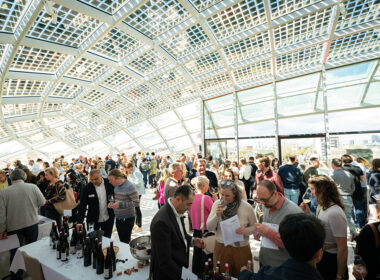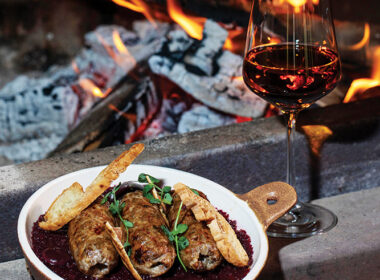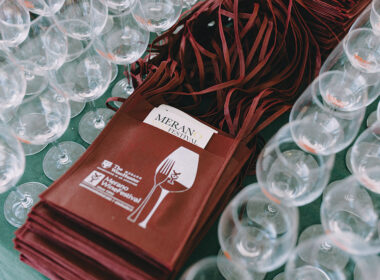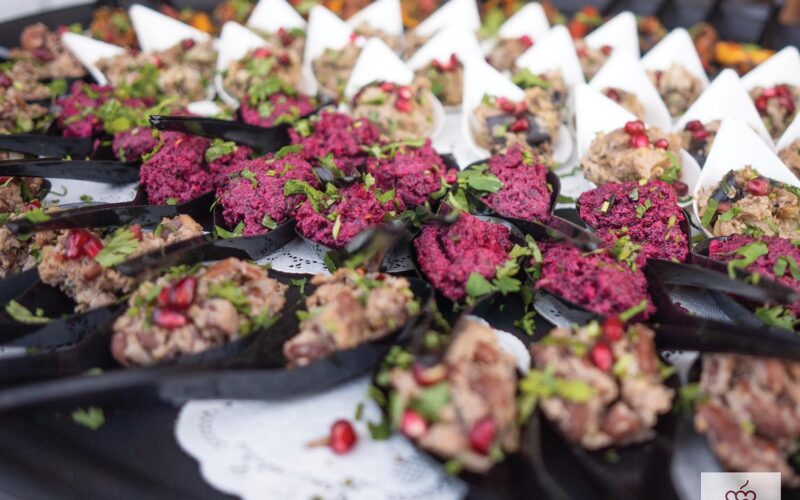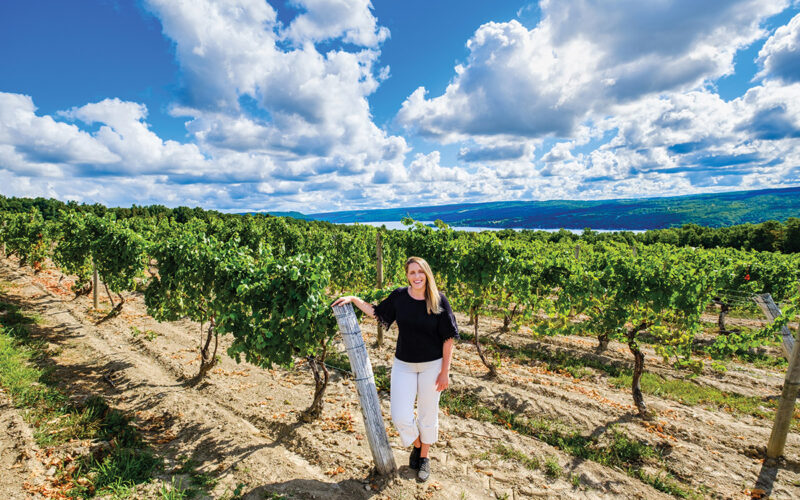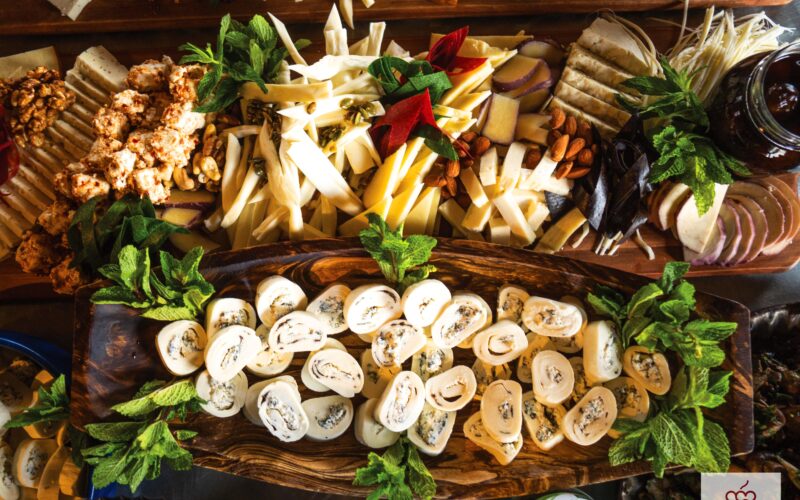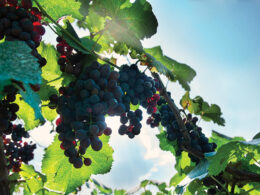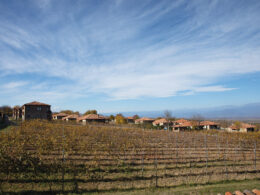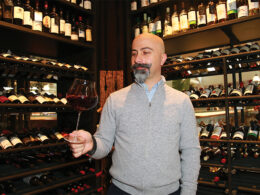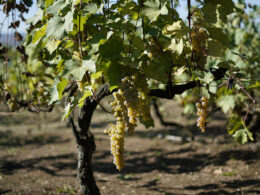Darra Goldstein | Guest speaker at Saperavi Festival | Author of The Georgian Feast cookbook
Q: Both food and wine are a very important part of the Georgian culture. Their popularity goes hand in hand in foreign countries as well. As such, Georgian gastronomy is an integral part of the Saperavi festival. Can you tell us a little about your love for Georgian cuisine and how it shaped your involvement in the festival?
A: I fell in love with the flavors of Georgia on my very first visit over 40 years ago. I had never tasted such exciting combinations of herbs and spices, or seen walnuts used to give richness and depth to so many savory dishes. Equally important was my experience of the supra – the abundance of food, the singing, the tamada, and his poetic toasts, and of course the wine!

Besides offering recipes, my cookbook The Georgian Feast highlights Georgian culture, and I made sure to include information about the ancient history and techniques of Georgian winemaking. Wine is such an important part of the Georgian meal, and of Georgian hospitality overall, that, when Lasha Tsatava and Erika Frey were organizing the Saperavi festival, they decided to include a session on Georgian food traditions and reached out to me. I was thrilled to participate.
Q: You’ve mentioned that recipes reveal history, they reflect culture. In your opinion what Georgian dish best reflects the culture and history of the country and the people? Do you, maybe, have a favorite one?
A: There are so many dishes that I love! The iconic one is, of course, the cheese bread called khachapuri, which comes in many different forms. But I think something like chakapuli reflects a more distinctively Georgian taste. It’s an aromatic lamb stew that’s slow-cooked to allow the flavors of white wine, tkemali (sour plum) sauce, and herbs like cilantro, dill, parsley, and mint to meld with the meat. Among my very favorite Georgian dishes are eggplant with walnuts and the vegetable pâtés known as pkhali.
Q: We know that wine can elevate food. Their pairing can create new tastes and dimensions. What can you tell us about Saperavi in this regard?
A: Saperavi is a wonderful wine because it goes so well with many different dishes. One of my favorite pairings is with duck, especially when the duck is prepared with a blackberry sauce that picks up on the dark berry notes in the wine. It’s a classic wine to serve with all sorts of grilled meats because of its spicy notes. And it’s great with charcuterie and hard cheeses. When Saperavi is young and not too tannic, it’s surprisingly good with churchkhela and pelamushi, two Georgian specialties made with the concentrated juice of freshly harvested grapes: grape on grape.
ქართული გემოები 40 წლის წინ თქვენს ქვეყანაში პირველივე სტუმრობისას შემიყვარდა.
დარა გოლდშტეინი
საფერავის ფესტივალზე მოწვეული სპიკერი | The Georgian Feast-ის ავტორი
Q: დარა, საფერავის ფესტივალმა წარმოადგინა როგორც ქართული ღვინო, ისე ქართული კერძები. ორივე ჩვენი ქვეყნის მრავალსაუკუნოვანი კულტურის განუყოფელი ნაწილია და მათი პოპულარობა მსოფლიოში სულ უფრო იზრდება. მოგვიყევით ქართული სამზარეულოს მიმართ თქვენი დამოკიდებულებისა და საფერავის ფესტივალში ჩართულობის შესახებ.
A: ქართული გემოები 40 წლის წინ თქვენს ქვეყანაში პირველივე სტუმრობისას შემიყვარდა. მანამდე არასოდეს გამესინჯა სანელებლებისა და მცენარეული კერძების ასეთი გამაოგნებელი კომბინაციები, ანდა კერძები, რომლებსაც ნიგვზის საკმაზი ასეთ მდიდარ არომატებსა და გემოებს სძენს. საინტერესო იყო ქართული სუფრის კულტურის გაცნობა – კერძების მრავალფეროვნება, სიმღერა, თამადის მიერ წარმოთქმული პოეტური სადღეგრძელოები და რა თქმა უნდა, ქართული ღვინო! ამიტომაც, რეცეპტების გარდა, ჩემს კულინარიულ წიგნში The Georgian Feast მკითხველს ქართულ კულტურაზე, მეღვინეობის მრავალსაუკუნოვან ისტორიასა და ღვინის დაყენების უძველეს ტექნოლოგიაზე ვუყვები.
როდესაც ლაშამ და ერიკამ „საფერიკას“ ფარგლებში ქართული გასტრონომიული ტრადიციის შესახებ სექციის ჩართვა გადაწვიტეს და მონაწილეობის მიღება შემომთავაზეს, ამ შესაძლებლობით ნამდვილად აღფრთოვანებული დავრჩი.
Q: რომელი ქართული კერძი გიყვებათ ჩვენი ქვეყნისა და ხალხის კულტურასა და ისტორიაზე ყველაზე უკეთ? ალბათ რჩეული კერძიც გექნებათ.
A: ბევრი კერძია, რომელიც მიყვარს, მაგრამ საკულტოდ მაინც ხაჭაპურს მივიჩნევ. ქართულ გემოებსა და ხასიათს კი ვფიქრობ, ყველაზე უკეთ ჩაქაფული გადმოსცემს. ცხვრის ხორცისგან მომზადებულ ამ საუცხოო კერძში შესანიშნავად არის გაერთიანებული თეთრი ღვინის, მწვანე ტყემლისა და სხვადასხვა მწვანილის არომატები. ფავორიტებს შორის აუცილებლად უნდა დავასახელო ფხალეული და ნიგვზიანი ბადრიჯანი.
Q: ღვინოს შეუძლია კერძის გემო და არომატები სულ სხვა სიმაღლეზე აიყვანოს, ამ ორის შეხამებამ კი სრულიად ახალი გემოები შექმნას. არის საფერავი თქვენთვის ასეთი ღვინო?
A: ჩემთვის ერთ-ერთი იდეალური შეწყვილებაა მაყვლის სოუსში (რომელიც ღვინის კენკროვან ტონებს საუკეთესოდ უსვამს ხაზს) მომზადებული იხვი და საფერავი. საერთოდ, ეს ღვინო, თავისი არომატული ნოტების მეშვეობით, ბრწყინვალედ ეხამება გრილზე მომზადებულ ყველა სახის ხორცეულს. კარგი წყვილია ძეხვეულთან და ყველთანაც. როდესაც საფერავი ახალგაზრდაა და ნაკლებად ტანინიანი, ძალიან უხდება როგორც ჩურჩხელას, ისე ფელამუშს.
Dave McIntyre | Freelance wine & food writer | Wine columnist for The Washington Post

Q: Dave, you have been writing about wine for many years. How did Saperavi get on your radar and what motivated you to get to know it?
A: I don’t remember the first time I tasted a Saperavi, but I’ve always been curious about the amazing variety of wine grapes and eager to try wine from grapes I’ve never tasted or heard of. Georgia has so many of those!
Q: You wrote a colossal article about Saperavi before the festival and have written other articles about Georgian wine(s) in the past. What do your readers seem to respond to when you write about Saperavi and Georgian wine(s)?
A: I think they respond to the same things I do: The history – birthplace of wine! – and the traditional methods of fermenting and aging wine in qvevri. Also, the idea of “natural” wine has become trendy over the past 12-15 years and Georgia fits into that.
Q: Sustainability is becoming more and more crucial in today’s world. Efficient use of resources and little to no intervention are some of the main characteristics of traditional Georgian winemaking. Do you think these factors influence the popularity of Georgian wine in the United States?
A: The premise of your question is spot on, but I believe the fascination with Georgian wines is more in the history and the qvevri tradition (and the trend to skin-fermented “amber” white wines). Sustainability is indeed crucial for the industry as a whole, but more and more artisanal producers around the world are moving in that direction. Georgia cannot set itself apart from the rest of the market that way. But the history, the variety of grapes (not just Saperavi!), and traditional winemaking distinguish Georgia from the rest of the world and make Georgian wine unique.
დეივ მაკინტაერი | Wine & food მწერალი | Washington Post-ის ღვინის მიმომხილველი
Q: დეივ, ბევრი წელია, ღვინოზე წერთ. როგორ მოხვდა საფერავი თქვენს ფოკუსში?
A: ზუსტად არ მახოვს, პირველად როდის გავსინჯე საფერავი, მაგრამ დანამდვილებით შემიძლია გითხრათ, რომ ყოველთვის ძალიან მაინტერესებდა ქართული ჯიშური მრავალფეროვნება და იმ ღვინოების დაგემოვნება, რომელთა შესახებ ბევრი არაფერი მსმენოდა. ასეთი ღვინოები კი ქართველებს მრავლად გაქვთ.
Q: ფესტივალამდე თქვენი ვრცელი სტატია გამოქვეყნდა საფერავის შესახებ. როგორია მკითხველების რეაქცია, როდესაც მათ ამ და სხვა ქართულ ჯიშებსა და ქართულ ღვინოზე უყვებით?
A: ისინი შესანიშნავად ხვდებიან, რომ მე მათ ღვინის სამშობლოზე, მის ისტორიაზე, ქვევრში ღვინის დაყენებისა და დავარგების მრავალსაუკუნოვან, ტრადიციულ მეთოდზე ვუყვები. სხვათა შორის, ბოლო 12-15 წელია, ტრენდული გახდა ნატურალური ღვინის მიმართულება, რომელშიც ძალიან კარგად, მეტიც – ორგანულად ეწერება ქართული ღვინო.
Q: დღევანდელ მსოფლიოში სულ უფრო გადამწყვეტი ხდება მდგრადი განვითარება, რესურსების ეფექტური გამოყენება და ნაკლები ჩარევა. ქართველი მეღვინეები ღვინის წარმოებისას სწორედ ამ ძირითად პრინციპებს ეყრდნობიან. როგორ ფიქრობთ, რამდენად უწყობს ეს ყველაფერი ხელს აშშ-ში ჩვენი ღვინის პოპულარიზაციას?
A: აქცენტები ძალიან სწორად გაქვთ დასმული, მაგრამ მე მაინც მგონია, რომ ქართული ღვინით დაინტერესებას მისი მრავალსაუკუნოვანი ისტორია, ტრადიცია და ქვევრში დაყენების მეთოდი უფრო განაპირობებს. ამ დარგისთვის სტაბილური განვითარება უდავოდ მნიშვნელოვანია და ამ გზას სულ უფრო მეტი არტიზანი მეღვინე ირჩევს. არც საქართველოა გამონაკლისი. ისტორია, ჯიშური მრავალფეროვნება (და არა მხოლოდ საფერავი!) ტრადიციული მეღვინეობა – აი, რა გამოარჩევს თქვენს ქვეყანას და რა ხდის მის ღვინოებს უნიკალურს.

